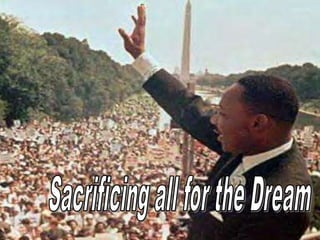
Martin luther king jr
- 1. Sacrificing all for the Dream
- 2. On 1st December 1955 Rosa Parks was arrested in Montgomery, Alabama for refusing to give up her seat to a white man while riding home from work on a bus.
- 3. In those days African Americans were expected to ride at the back of the bus and surrender their seats to white people when required.
- 4. Dr Martin Luther King, Pastor of a Baptist church in the town, felt that a protest was needed. He held a meeting, and it was decided to boycott the buses. For 382 days 17,000 black people walked to work, or hitched a lift.
- 5. It was the first non-violent demonstration. During this period the black people of Montgomery suffered continuous harassment and intimidation. One day Martin Luther King was arrested. On another occasion his house was bombed nearly killing his daughter. However, on December 21st 1956, segregation on the buses was declared unlawful.
- 6. After this, Martin Luther King headed up a Civil Rights organisation. Their motto was: ‘Not one hair of one head of one person should be harmed.’ He wrote a book titled ‘Stride Toward Freedom.’
- 7. African-American parents protesting against the policy of segregating black and white schoolchildren in the public schools.
- 8. A segregated city bus in the South. Notice that whites sit in the front of the bus, while African Americans sit in the back. Montgomery
- 9. Students in Greensboro, North Carolina decided to stage a ‘sit-in’ at a restaurant which refused to serve African Americans. They were often assaulted by white people, but they never hit back.
- 10. A Birmingham, Alabama police officer turning a dog on a black demonstrator in May, 1963.
- 11. After six months of peaceful protest many restaurants, swimming pools, libraries and theatres in 26 cities had become de-segregated.
- 12. Martin Luther King realised that African Americans, who made up 10% of the population, had political power as well as economic power.
- 13. In the Southern states of America black people were discouraged from voting by the Klu Klux Klan. This was a racist group who intimidated black people from registering to vote by setting fire to their houses, and carrying out murders.
- 14. However in 1960 John F. Kennedy was elected president because 70% of registered African Americans voted for him.
- 15. However, the President took two years to bring the promised Civil Rights legislation before Congress.
- 16. In 1963 Martin Luther King led 250,000 people in a peaceful march to Washington, ‘for jobs and freedom’. It was here that he delivered his famous ‘I Have a Dream’ speech.
- 17. President Kennedy was assassinated while the bill was still under discussion. However it was taken up by President Lyndon Johnson, and it became law in 1964. Racial discrimination was now illegal, and employers were required to provide equal employment opportunities
- 18. Now Martin Luther King turned his attention to bringing an end to the Vietnam War. He knew that money spent on the war was preventing the government from improving the Welfare system, and helping the poor.
- 19. At the age of 35 Martin Luther King was the youngest person ever to receive the Nobel Peace Prize. He handed over his prize of nearly $55 million dollars to the Civil Rights Movement.
- 23. ‘I just want to do God’s will. He’s allowed me to go up the mountain, and I’ve looked over. I’ve seen the promised land. I may not get there with you, but I want you to know that we, as a people, will get to the promised land…..’
- 24. As he walked out on to the balcony of his hotel that evening, a single gun shot rang out. Martin had been struck down by an assassin’s bullet.
- 25. Assassination in 1968 He is lying on the floor and witnesses are pointingto where the shots came from.
- 26. His funeral was held five days later. A crowd of 70,000 stood at the sides of the street to watch his cortege pass.
- 27. On his crypt were carved the words: Free at last! Free at last! Thank God Almighty I’m free at last.
- 28. In 1986 Martin Luther King’s birthday on January 15th became a national holiday. He has become a symbol of hope for African Americans and America as a whole.
- 29. THANK YOU! For Your Attention!
Notes de l'éditeur
- People believed that the African-American people had lived in freedom since the Civil War. ButDr. King defined freedom as more than the absence of slavery. He viewed a free society as a society in which all peoplehad equal access to public places, had the right to vote, could obtain a quality education could obtain a quality education.
